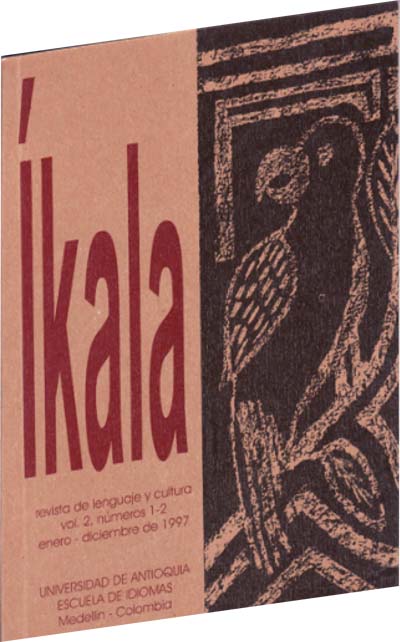Acquisition of a foreign language by solving communication problems.
DOI:
https://doi.org/10.17533/udea.ikala.8043Schlagworte:
foreign language, foreign language teaching, communication problems, educational materialsAbstract
Teaching of foreign languages (FL) is a discipline that has resulted from a long historical development and has been nourished by diverse knowledge. Consequently, its practice leads to healthy discrepancies and a great variety of methodological proposals. However, there has often been a division between the theoretical-philosophical postulates of the different methodological approaches and their daily practice in the classroom. Some of the instructional approaches have claimed to have FL communication as the ultimate goal, nevertheless, innumerable didactic implications derived from the concept of communication have remained untransferred to the practice of the foreign language classroom. An insistence on the merely linguistic aspects, particularly in the four skills, has led to a neglect if not oblivion of the extra and paralinguistic symbols, which distorts the communication process. What often occurs then is a separation between the communication proclaimed in the methodology and in the syllabus, and the praxis that takes place in the classroom, since the foreign language as a system ( focusing on grammatical and phonetic rules, etc.) continues to be emphasized and not the performance in FL (with its semantic and pragmatic dimension). This mistaken comparison between linguistics and communication has led to an erroneous methodological praxis, with disastrous consequences for coherence and efficacy.
Downloads
Literaturhinweise
ARIAS, Rodrigo, Duque, Alvaro & Mitchell, Yanik. Efectividad del empleo de los materiales auténticos en el proceso de adquisición de un alengua extranjera. Informe de investigación. Universidad de Antioquia, Medellín,, 1993
CARREU, Patricia. Three COmponets of Background Knowledge in Reading Comprehension. Language Learning, vol. 33, No. 2, June 1983.
_______. Evidence of a formal Schema in Second Language Comprehension. Language Learning, Vol. 34. No. 32. June 1984
________. Facilitating ESL Reading by Teaching Text Structure. TESOL Quartely. Vol. 19, No. 4, December 1985
CHOMSKY. Noam. Selected readings. Allen & Burden Ed. OUP. 1 971
FAERCH, Claus & Casper, Gabriele. Two Ways of Defining Communication
Strategies. Languages Learning. Vol. 34, No. 1 , March 1984
FlOYD, Pamela & Carrell. Patricia. Effects on ESL Reading of Teaching Cultural
Content Schemata. Language Learning. Vol. 3 7. No. 1, March 1 98 7.
HUDSON, Thom. The Effects of induced Shemata on the "Short Circuit in L2
Reading Performance. Language learning, Vol. 32, No. 1, June 1982
JOHNSON. Patricio. Effects on reading Comprehension of Buiding Background
Knowledge. TESOl Quarterly. Vol. 16, No. 4, December 1982
KRASHEN. Stephen. Principles and Practice in Second language Acquisition.
Pergamon Press, Oxtord, 1982
OXFORD. Rebecca. Language learning Strategies. Newbury House. Moss. 1990
PARSLOV. Eric (Ed.). Interactive Video. Wilmslow. 1983
WlDDOWSON, Henry. Aspects of language Teaching. OUP, 1990
Downloads
Veröffentlicht
Zitationsvorschlag
Ausgabe
Rubrik
Lizenz
Copyright (c) 1997 Íkala, Revista de Lenguaje y Cultura

Dieses Werk steht unter der Lizenz Creative Commons Namensnennung - Nicht-kommerziell - Weitergabe unter gleichen Bedingungen 4.0 International.












